Knowing how to fix a bike puncture is an essential skill that every cyclist needs to master. It can be daunting for the inexperienced but only takes a few minutes once you know what you're doing.
In the following guide and videos below, we'll talk you through how to repair a punctured inner tube on either a road or mountain bike in a simple, step-by-step guide.
You can skip to specific sections by hitting the links below:
- How to fix a puncture on a bike step-by-step guide
- How to identify a puncture
- Which puncture repair kit should I buy?
- Which are the best tyre levers?
- Which is the best pump?
- Weekly check-up for tyres
- Tubeless punctures
How to fix a puncture on a mountain bike video guide
How to fix a puncture on a road bike video guide
How to fix a puncture on a bike
Step 1. Find the puncture

Using the valve as your starting point, closely inspect the tread of the tyre to find the cause of the puncture.
Pay close attention to the sidewalls (the non-treaded portion on the side of the tyre where the pressure and size information is printed/moulded) to make sure there are no tears or holes.
Remove any glass, grit or other debris that you spot. A small flat-head screwdriver or awl is the best tool for this, but be careful not to dig too deep. A small set of pliers can also be useful for removing embedded thorns.
Even if you find one possible cause of the puncture, continue checking the tyre thoroughly until you get back to the valve because there could well be more.
Step 2. Remove the inner tube

Let the air out of the inner tube and push the valve up into the tyre, unscrewing and retaining the valve lockring if fitted.
On the side of the wheel opposite the valve, slip a tyre lever under the tyre’s bead and a further tyre lever about roughly 5cm away.
Pull the nearer tyre lever towards you, lifting the tyre’s bead over the edge of the rim. Continue until one bead of the tyre is completely free of the rim then pull the tube out.
Remove the tyre completely from the rim – with most tyres this can be done by hand unless they are exceptionally tight.
Step 3. Locate the puncture on the inner tube
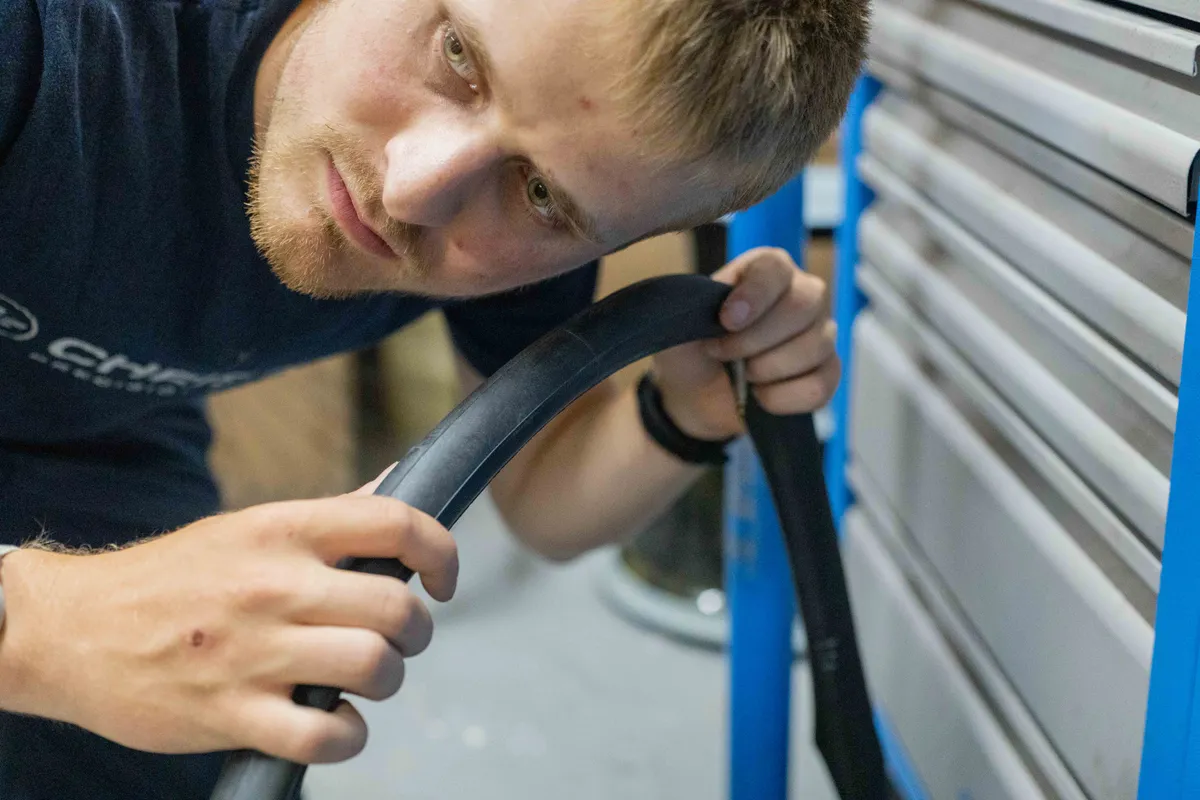
If you are just going to replace the inner tube, skip to step 6.
If you want to patch the inner tube – and you ought to, it's not that hard! – inflate the tube and listen for air escaping.
If you're struggling to find the hole by listening alone, try passing your lips over the top of the tube.
If the hole still can't be found, re-inflate the tube and pass it through a bowl of water, or rub the tube down with soapy water, until you spot escaping bubbles. Be sure to dry the tube before proceeding to the next step.
Step 4. Prepare the inner tube for patching
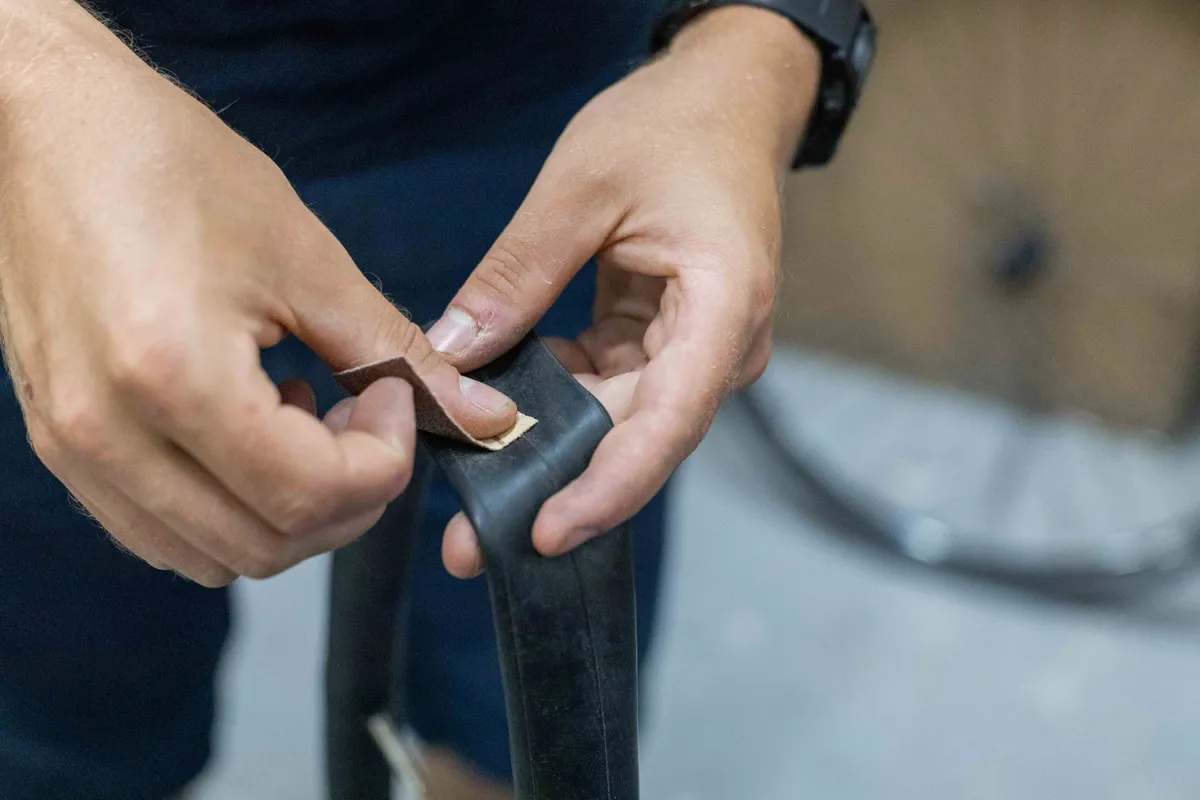
Select an appropriately sized patch – if in doubt, err on the side of caution and use a bigger rather than smaller patch.
Roughen the surface of the tube around the hole with sandpaper (usually included with any good puncture repair kit).
Ensure that any moulding marks on the tube are completely flattened down because these can cause issues when glueing. Thoroughly brush off any rubber 'shavings'. Cleanliness is key when repairing a puncture.
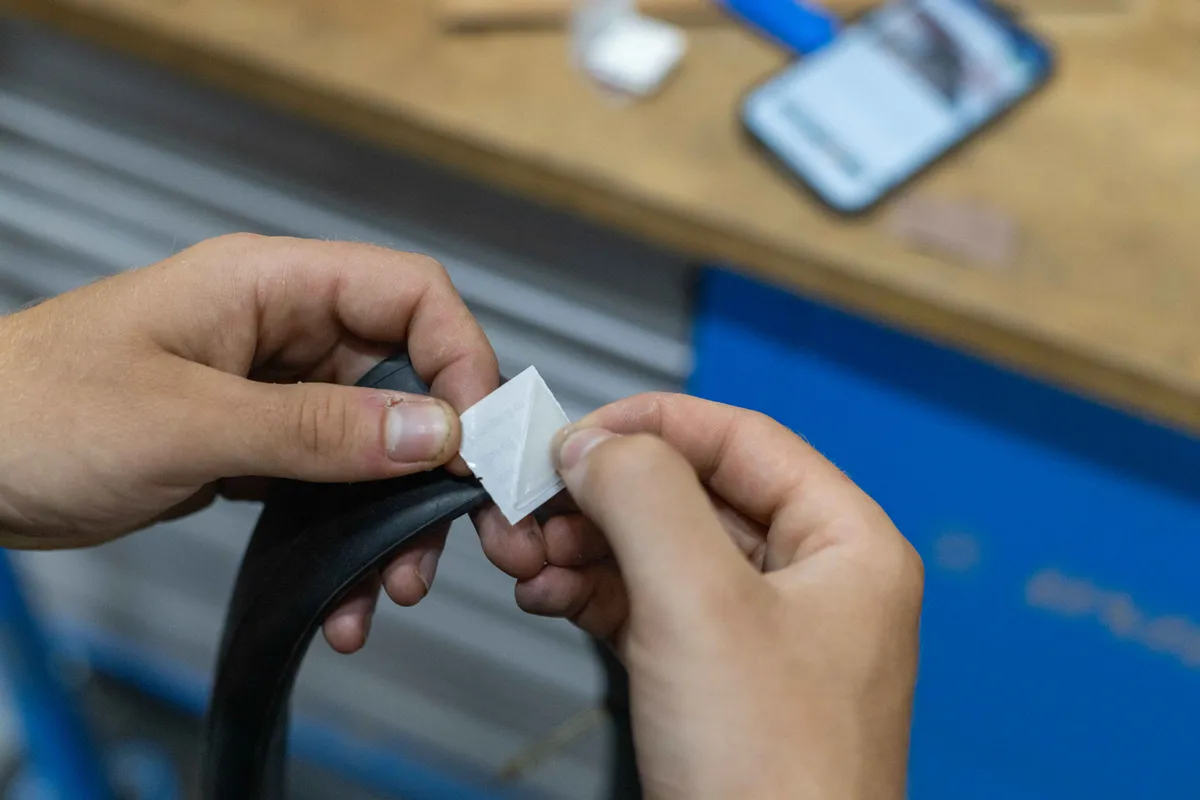
If you're using pre-glued patches – such as Park's popular GP-2 patch kit – you can now patch the hole. Thoroughly press down on the patch to ensure it's fully in contact with the tube.
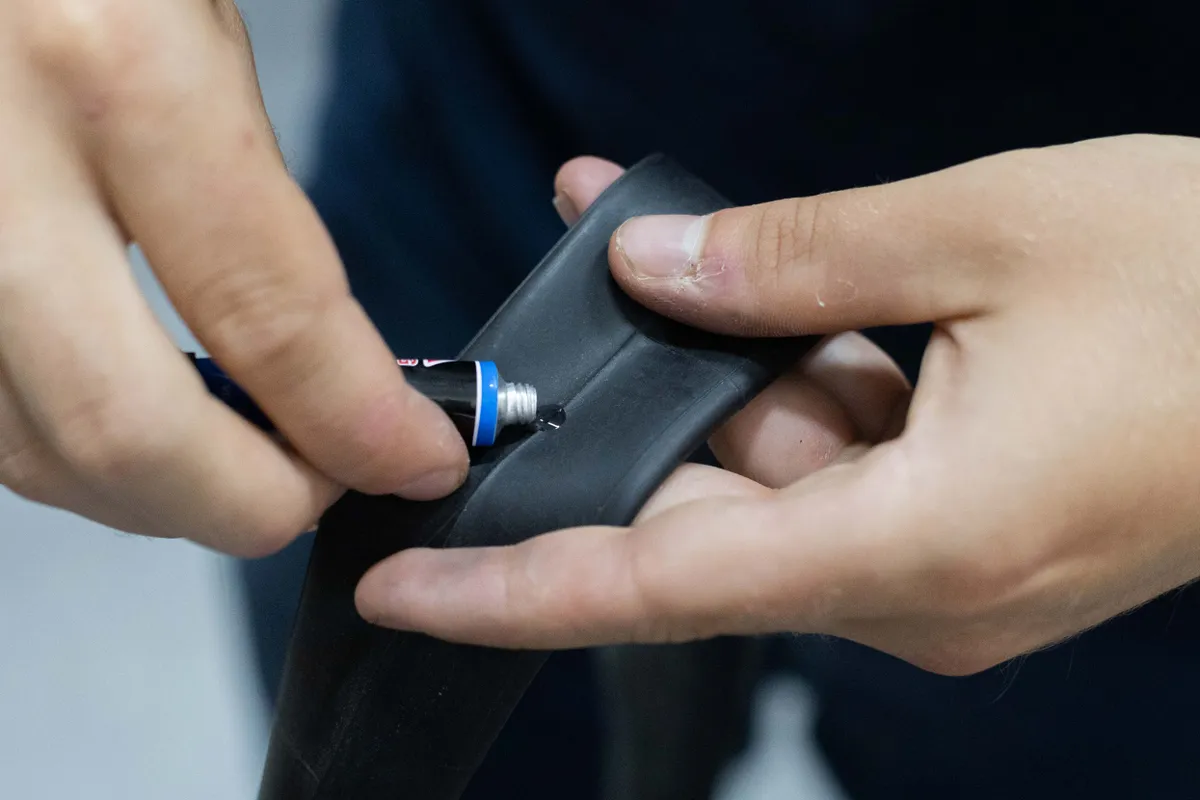
If you're using a 'traditional' glue-on patch kit, start by applying a generous drop of glue – or rubber cement by its proper name – to the tube and spread this across an area slightly larger than the patch you intend to use. Allow this to dry.
Similarly, apply a second, thinner layer. Once again, allow to dry – when the glue is dry, its surface will change from a shiny to a matte finish.
The key to ensuring a good long-lasting puncture repair is patience, so don't rush this step.
Step 5. Patching an inner tube

Firmly press the patch into place after removing the backing foil – cleanliness is also key to a good repair, so leave removing the foil to the very last moment.
If there’s a thin cellophane backing on the patch, it can be left on. It's good practice to dust any stray glue with chalk, talcum powder or fine road dust to prevent it from sticking to the inside of the tyre casing.
Step 6. Inspect the tyre casing and rim tape
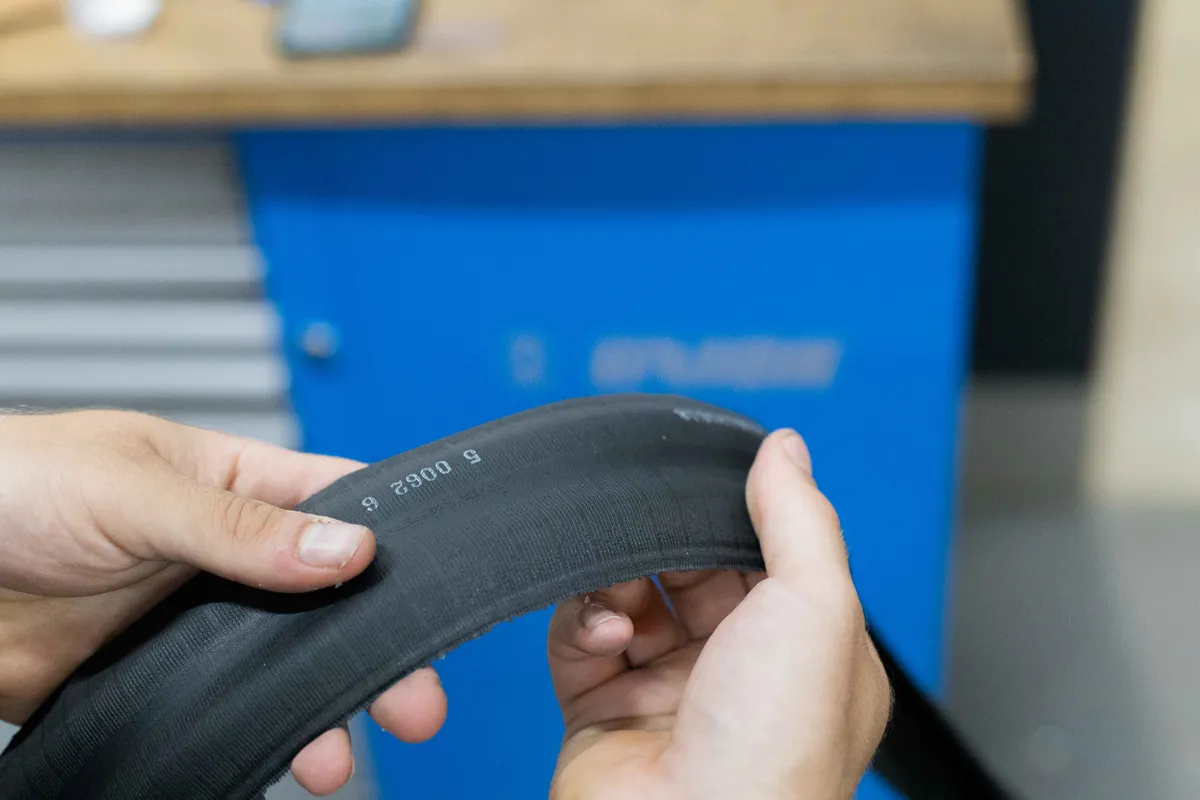
Before refitting the tube, thoroughly double/triple-check the inside of the tyre casing – there's nothing more frustrating than going to the effort of patching a tube only to puncture it again with a stray thorn you may have missed.
It's also good practice to check the rim tape. If a hard plastic rim strip – often found on cheaper bikes – is torn, it leaves a sharp edge that can easily slice a tube.
Likewise, if your rim tape has slipped, it can leave eyelets or spoke holes exposed, which can also puncture a tube.
If you have persistent problems with your rim tape puncturing your tube, try swapping it out for something like a roll of good ol' Velox cloth tape or similar. This stuff lasts forever, costs very little and can be reused if you're so inclined.
Step 7. Refit the tyre
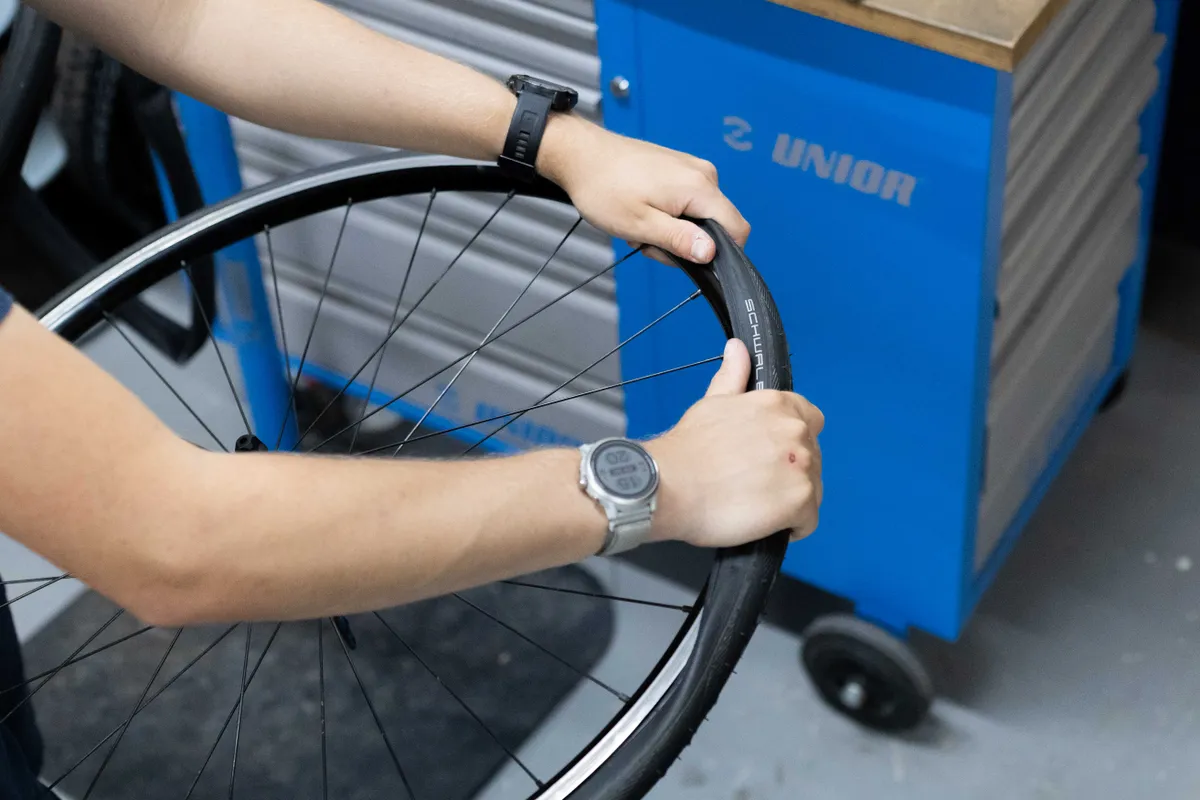
After repairing the tube and thoroughly checking the tyre, refit one side of the tyre – one bead, to use the correct term – to the rim.
Slightly inflate the tube (just enough to give it structure) and refit it to the wheel, putting the valve through its hole first.
Starting at the opposite side of the rim to the valve, use your thumbs to lift the tyre’s bead over the rim. Work your way around the rim until there’s just one small section of tyre left.
Push the valve up into the tyre and then, using your thumbs, ease the remaining section of the tyre’s bead over the edge of the rim.
If the tyre is particularly tight, avoid the temptation to use a tyre lever to push the last section of the tyre onto the rim – you'll almost certainly pinch your inner tube doing so.
If you're struggling to pop the tyre onto the wheel, try putting the tyre on the ground, holding it in place with your feet and rolling the bead back toward you – heavy gloves really help here. This takes a little practice, but should work with even the most stubborn tyres.
Step 8. Check the repair and inflate the tyre

Check that the tube isn't trapped between the rim and the tyre bead by working your way around the tyre, pushing the bead into the well of the rim.
If the tube is trapped, try 'massaging' the tyre to encourage it to seat properly. Pumping it up a small amount may also help to seat the tube properly.
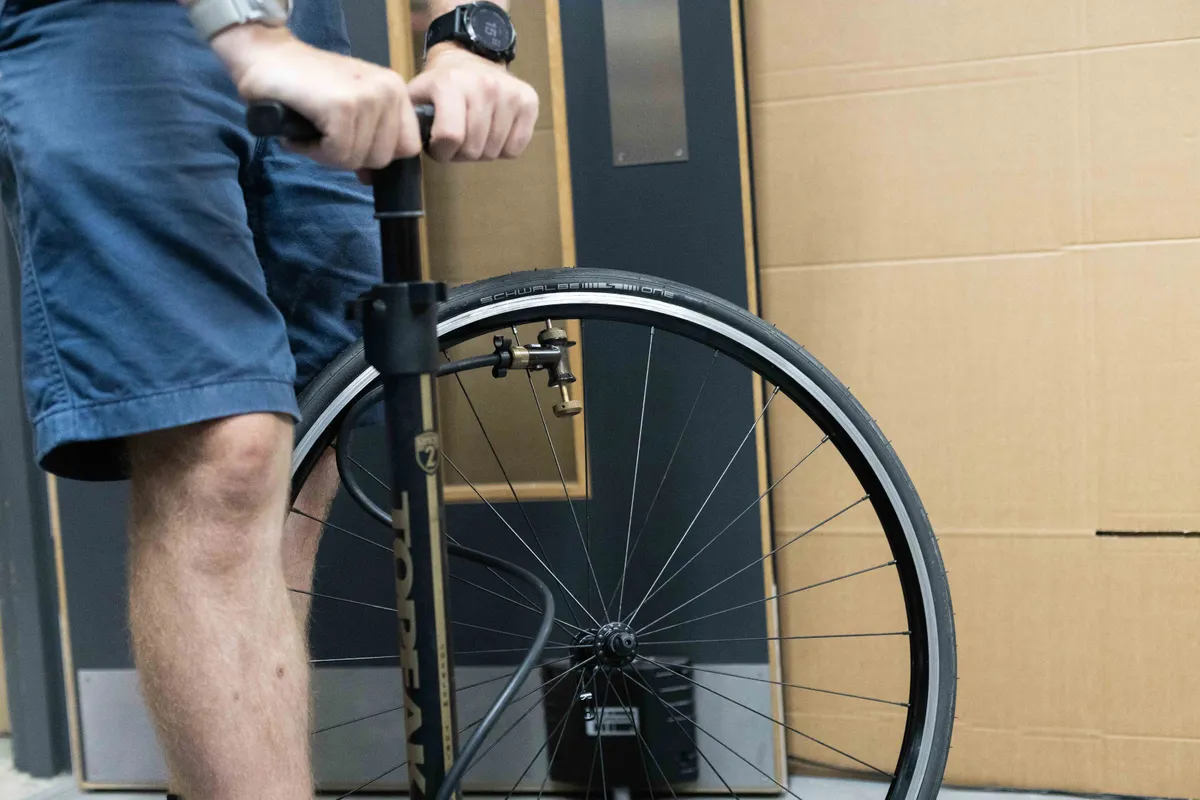
Inflate the tyre to a point where it feels soft but has maintained its shape. Then check that the moulding mark around the tyre follows the rim evenly all the way around.
If not, deflate a little and ease any high spots down and pull low spots up until the bead is fitted evenly.
Inflate fully and check once again that the tyre’s bead is still seated evenly and that the tyre isn't lifting off the rim at any point, then adjust your pressures to suit.
Fixing a puncture: useful tips
- When taking the tube out of the tyre, note which way the tube was around in the wheel. This will help identify the position of the hole in the tube once the position of the object in the tyre causing the puncture has been found
- Once you've located the hole in your puncture, mark it with a piece of chalk (usually included with a repair kit) so you can pinpoint it accurately later
- If you don't have any sandpaper, you can try gently to roughen the tube by rubbing it against a stone or the road surface, but be very careful
How to identify a puncture
'Regular' puncture
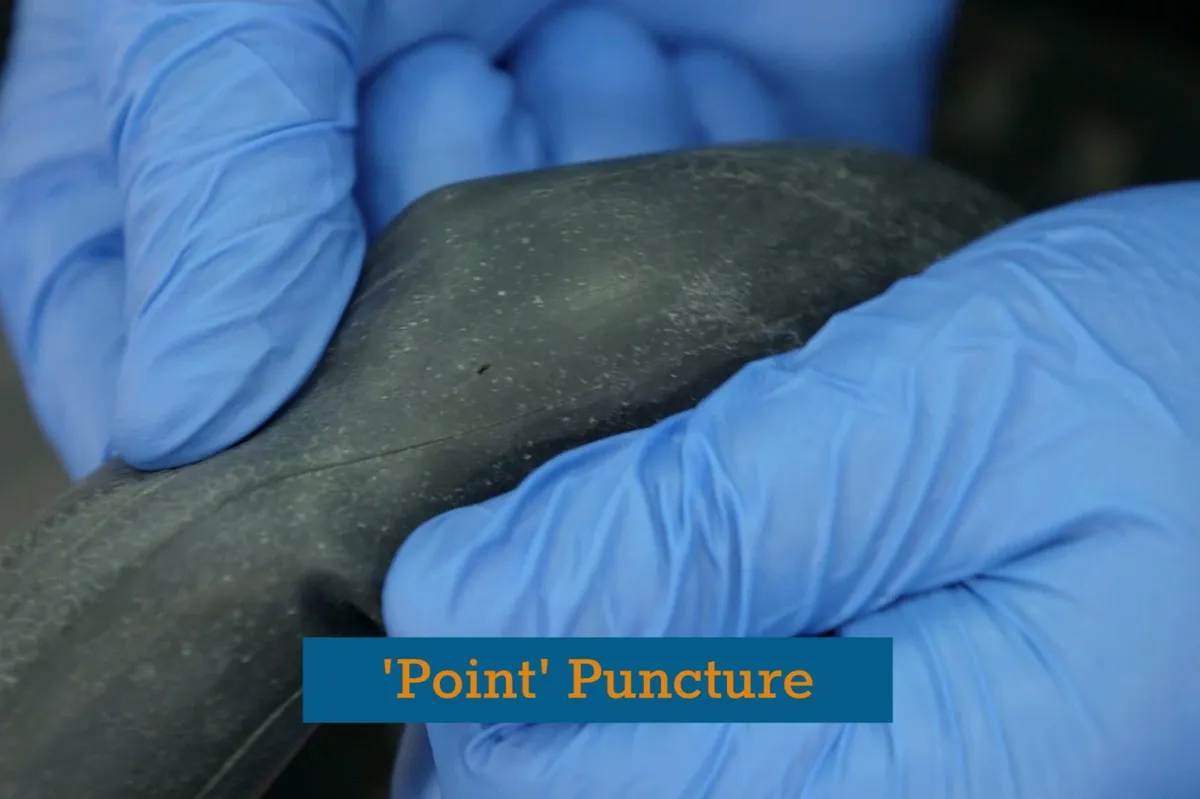
A 'regular' puncture is usually caused by debris – glass, thorns, wire, nails etc. – entering the tread of the tyre and piercing the inner tube.
There's little you can do to avoid these types of puncture beyond opting for puncture-resistant tyres. While effective, these are best saved for town or commuting bikes because they tend to weigh a lot more than regular tyres and really dampen the ride quality of a bike.
Those unfortunate enough to get punctures regularly may have noted that they tend to get more flats during wet weather. This is because surface water essentially acts as a lubricant, allowing anything sharp to enter the tyre more easily.
Wet weather allows debris that would otherwise stay on the ground to stick to your tyre more easily too, with the rotation of the wheel slowly driving it into your tyre.
Snakebite/pinch punctures
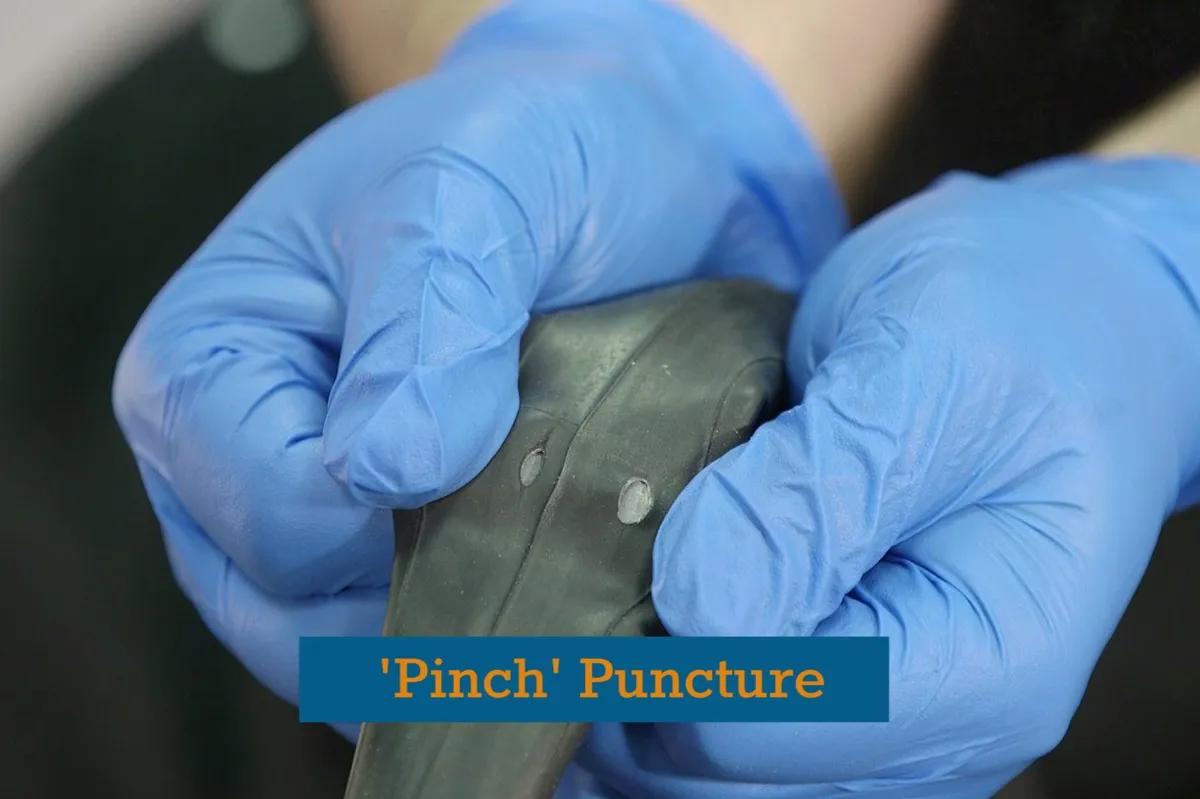
Two small holes in a tube placed fairly close together indicate a pinch – or snakebite by its other name – puncture. This is caused by the tube getting trapped between the tyre and the rim when riding over a hard-edged object, such as a prominent rock or a kerb.
Tyres that are not inflated enough are the most frequent cause of this. If you consistently get pinch flats, particularly on a mountain bike, it may be time to convert to tubeless.
If you have a pinch flat, be sure to check that the tyre’s sidewall isn't cut as well.
Rim tape or spoke puncture
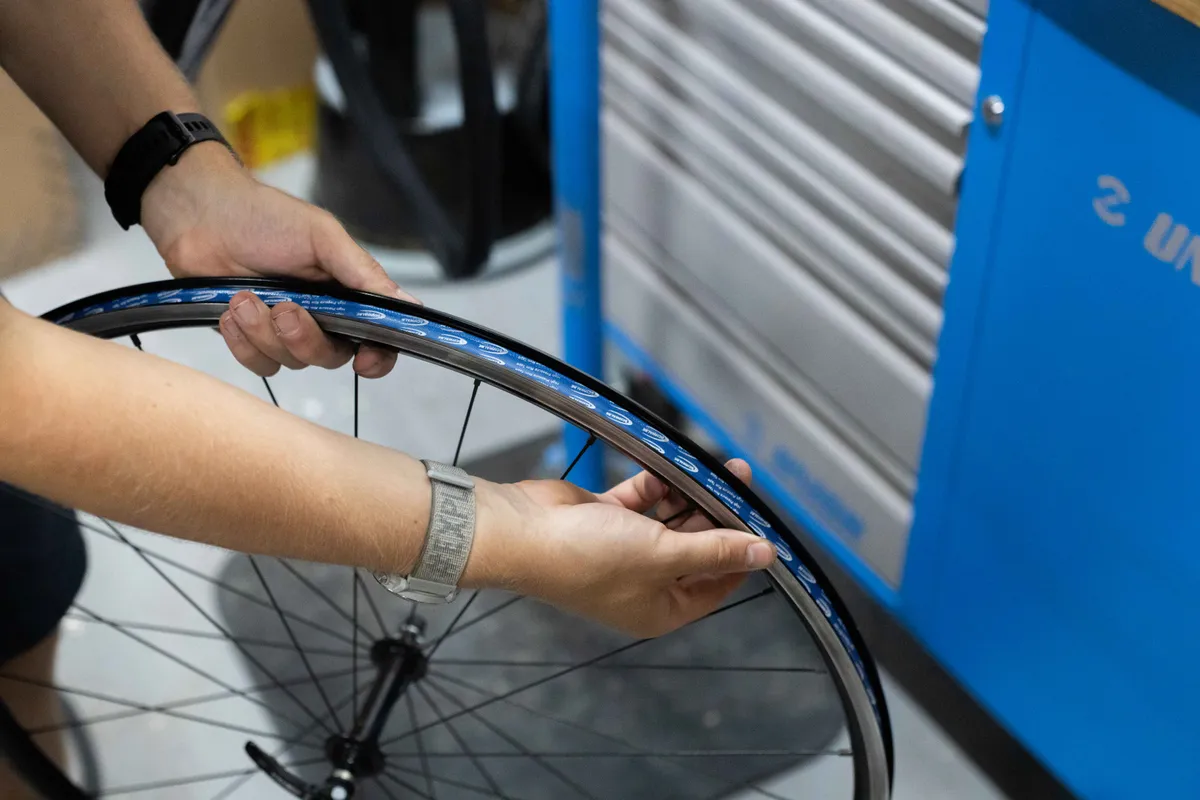
A hole on the inner side of the tube indicates that the puncture was caused by something around the well of the rim, usually a rough edge on a spoke hole or torn rim tape if it is made of hard material.
Check around the inside of the rim to ensure that the rim tape properly covers the spoke holes and that all spoke holes are free of swarf – if you find any sharp edges, these can usually be filed down.
A less common cause of a puncture is a rough edge around the valve hole. A puncture here will occur at the base of the valve and will not be repairable.
Which puncture repair kit should I buy?

The puncture-fixing brigade is divided into two distinct camps: those that insist on using an old-school, glue-on patch kit and those that prefer pre-glued patches.
In our experience, traditional glue-on patches are more reliable in the long run, but pre-glued patches are far, far more convenient.
What you prefer to use will largely be down to personal preference and likely dictated by your temperament – is stopping for five minutes to fix a tube properly and enjoying the view an opportunity to be relished or an unwanted distraction?
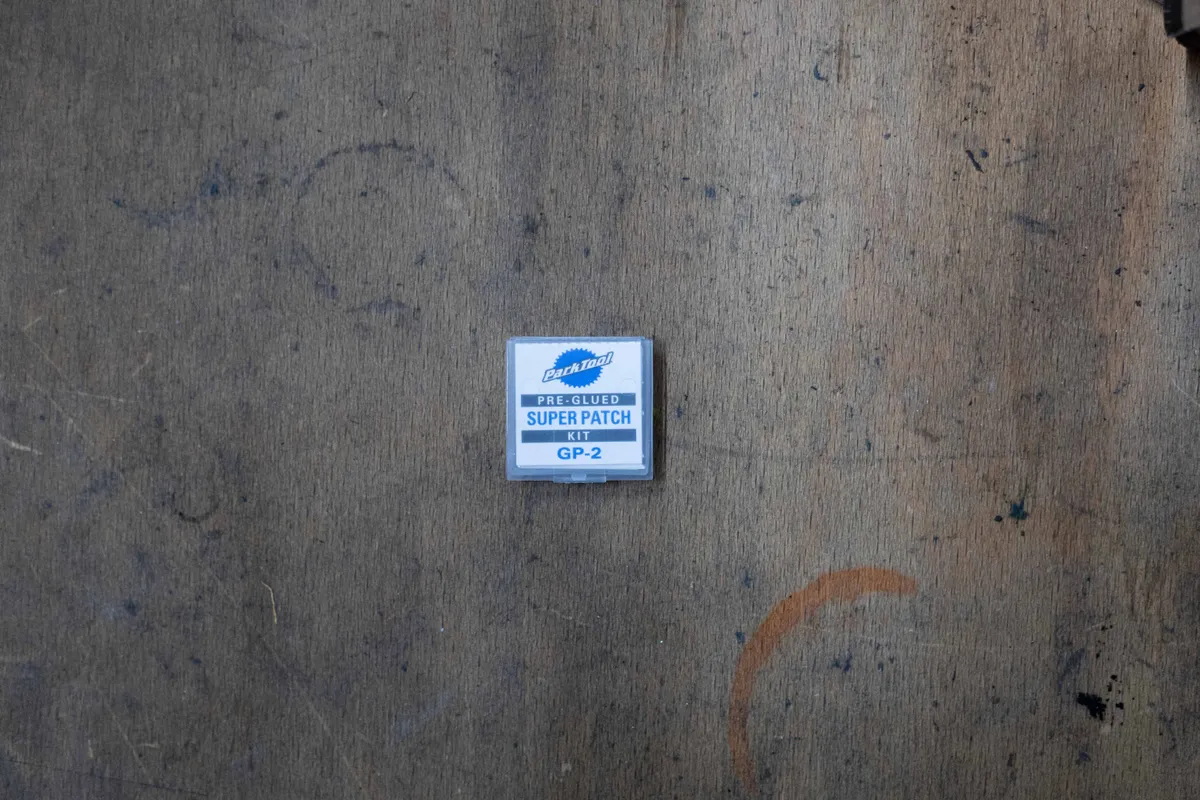
For those that want pre-glued patches, Park's GP-2 patches are our favourite.

For an old-school style patch kit, it's hard to beat the exceptionally cheap Nutrak P3 kit or Park Tool's VP-1.

For those after a more Gucci patch kit – yes, such a thing exists – you can bring a bit of French charm to your saddle bag in the form of this handsome patch kit from Rustines.
Whichever patch kit you buy, if it comes with one of those nasty little multi-tools that feel as though they're made from cheese rather than metal, please put it into your nearest recycling point. Trust us when we say that they'll do more harm than good to your bike.
It's also a good idea to pack a pair of gloves with any repair kit. Braking surfaces, particularly rim brake surfaces, will make an absolute mess of your hands and nobody wants to inadvertently grab a stray patch of dried-out dog poop on a tyre with bare hands.
Which are the best tyre levers?
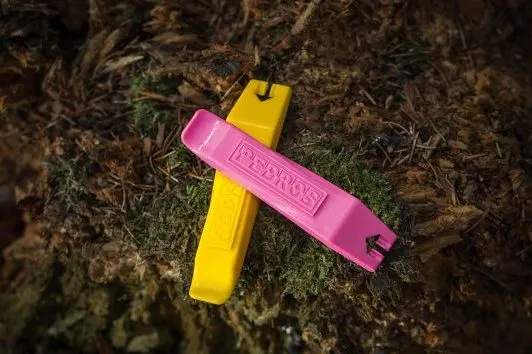
Believe it or not, not all tyre levers are made equal.
Thankfully, we've done the hard work for you, whittling down a selection of the best tyre levers out there, with Pedro's levers coming out on top.
Which is the best pump?
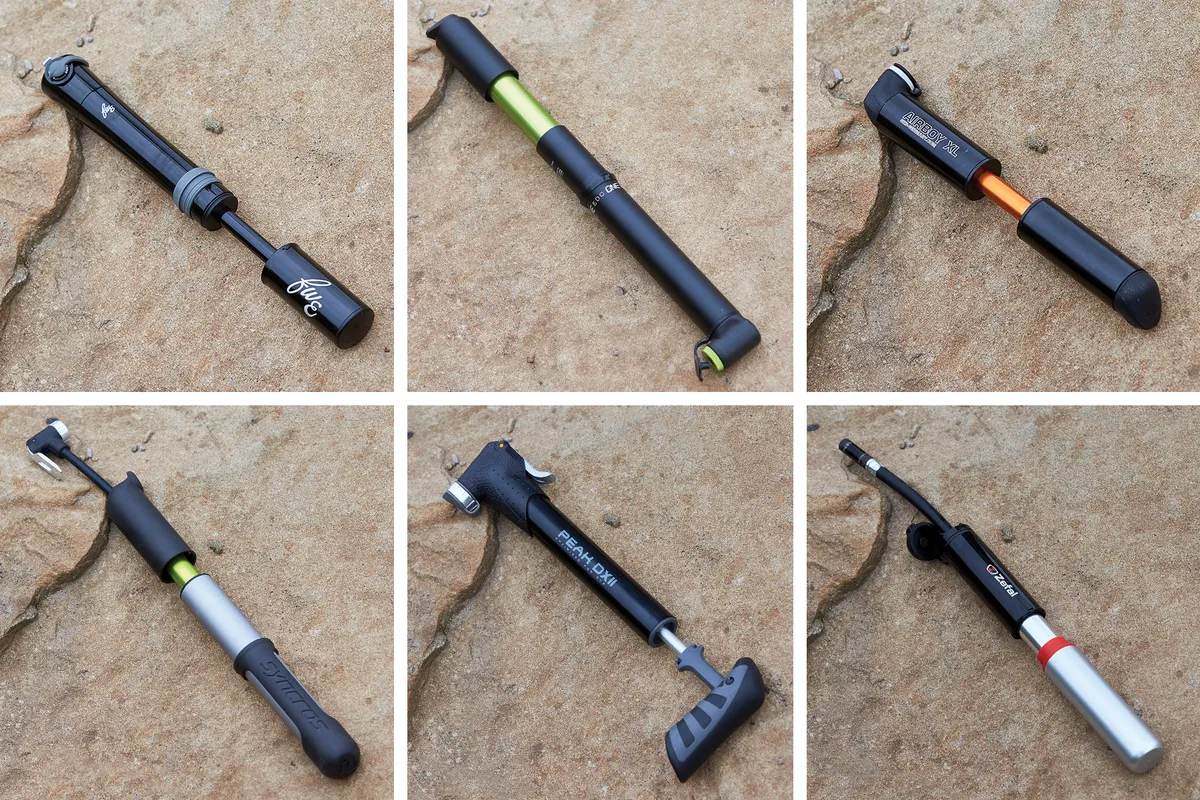
While a mini pump is a great option if you're out on the road, do yourself a favour and get a decent track-style pump for use at home – these take far less effort to use than a mini pump and will allow you to get your tyres up to much higher pressures.
If you prefer to take a CO2 inflator with you, check out our round-up of the best CO2 inflators.
Weekly check-up for tyres
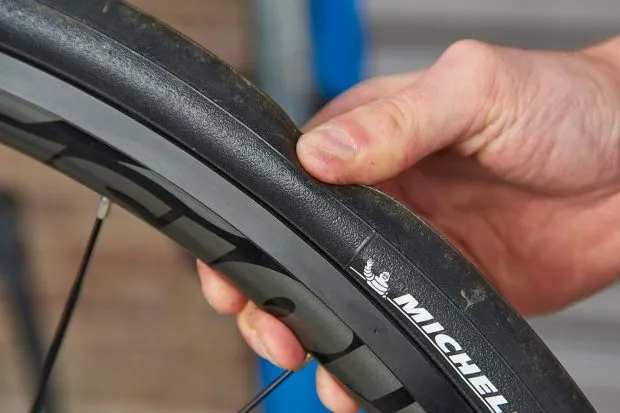
Check your tyres for cuts in the tread, swelling in the sidewall or serious wear.
Tyres with severe cuts, swelling or casing visible through the tread must be replaced. Remove any grit or glass embedded in the tread with a fine pick.
Regularly check your tyre pressures with a proper gauge. Tyres inflated to the correct pressure will have fewer punctures and a longer life.
We've got full guides to road bike tyre pressure and mountain bike tyre pressure, so you can optimise your setup to balance speed, comfort, grip and puncture resistance.
Tubeless punctures
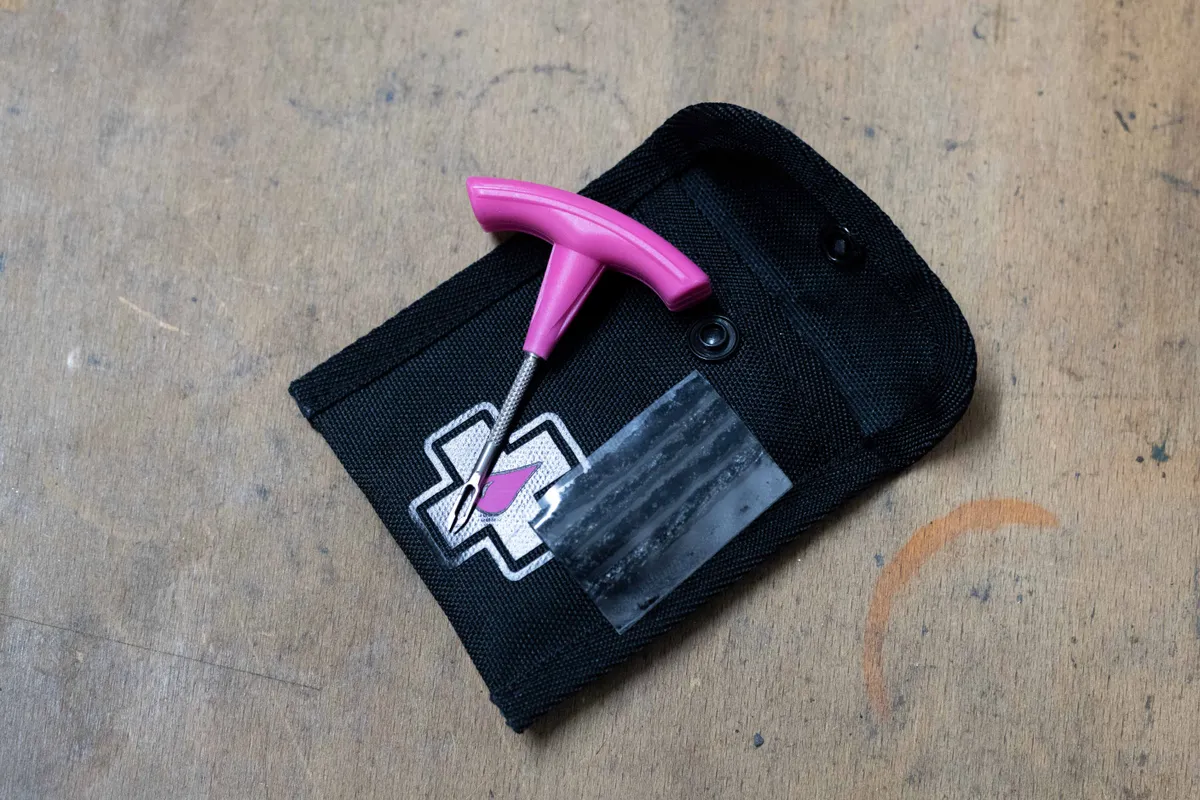
A tubeless tyres setup relies on sealant to quickly plug any small holes, preventing a full-blown puncture, but occasionally the size of the hole might be too large to plug.
To repair a punctured tubeless tyre, you'll need to use a specific tubeless repair plug tool. The plug effectively patches the hole and you'll then need to re-inflate your tyre to the desired pressure.
